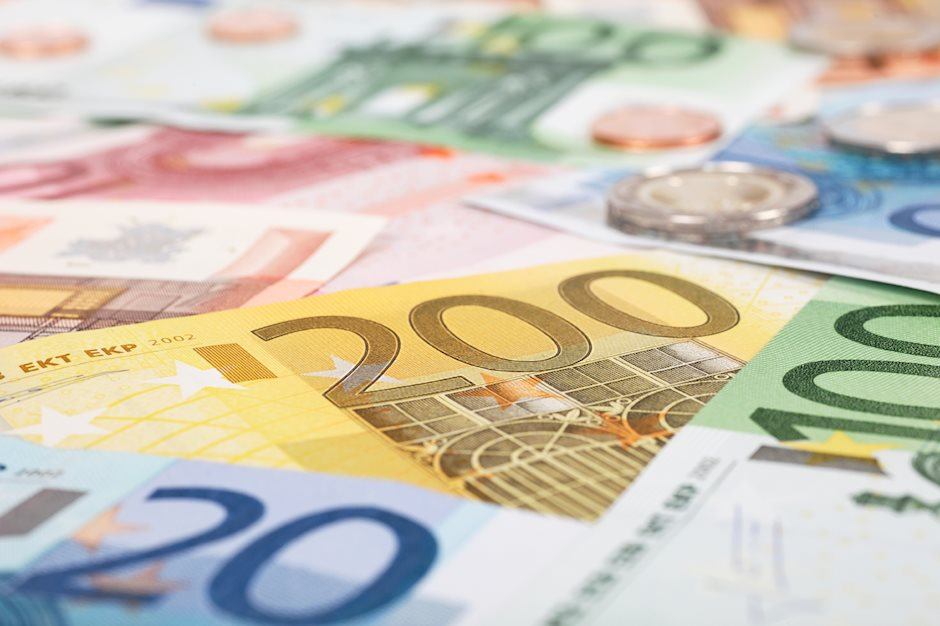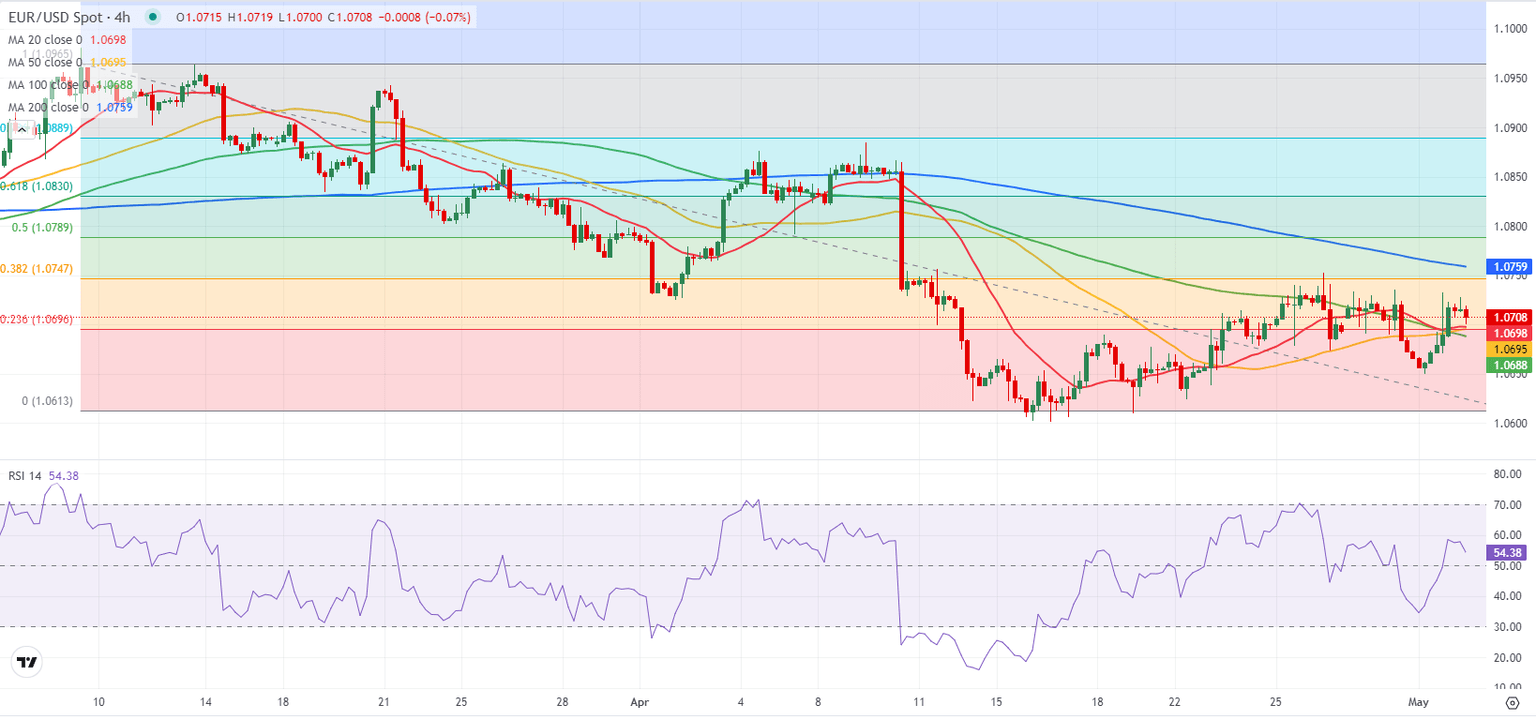EUR/USD Forecast: Euro looks to test 1.0750-1.0760 resistance area
- EUR/USD holds steady above 1.0700 after closing in the green on Wednesday.
- The Fed left the policy rate unchanged, introduced changes to QT strategy.
- The US Dollar struggles to find demand ahead of mid-tier data releases.

EUR/USD gathered bullish momentum in the late American session on Wednesday and closed the day in positive territory. The pair holds steady above 1.0700 in the European session on Thursday, while the technical outlook points to a bullish tilt.
The Federal Reserve (Fed) left the interest rate unchanged at 5.25%-5.5% following the April 30 - May 1 policy meeting, as widely expected. In its policy statement, the Fed announced they will slow the decline of the balance sheet by cutting the Treasury redemption cap to $25 billion per month from $60 billion starting June 1.
When asked about the possibility of policy tightening in the face of persistent inflation, Fed Chairman Jerome Powell said that it was unlikely that the next interest rate move would be a hike. Powell refrained from providing any clues regarding the timing of the policy pivot but said that it was likely that it will take longer than previously anticipated to gain the greater confidence in inflation moving toward the 2% target to lower the policy rate.
The US Dollar (USD) suffered large losses as the Fed event turned out to be not as hawkish as feared, with the USD Index falling over 0.6% on the day. Early Thursday, the USD Index holds steady above 105.50 and limits EUR/USD's upside.
Later in the day, the US Department of Labor will release the weekly Initial Jobless Claims data. The US economic docket will also feature the Unit Labor Costs data for the first quarter, which is expected to rise 3.2% following the 0.4% increase recorded in the previous quarter. A stronger-than-forecast print could help the USD erase some of its post-Fed losses, while a soft print could further weigh on the currency. Nevertheless, the market reaction could remain short-lived, with investors awaiting Friday's Nonfarm Payrolls data.
EUR/USD Technical Analysis
The Relative Strength Index (RSI) indicator on the 4-hour chart rose above 50 and EUR/USD closed the last three 4-hour candles above the 100, 50 and 20-period Simple Moving Averages (SMA), reflecting the bullish tilt in the short-term outlook.
On the upside, key resistance area seems to have formed at 1.0750 - 1.0760 (Fibonacci 38.2% retracement of the latest downtrend, 200-period SMA). If EUR/USD stabilizes above that region, 1.0790 - 1.0800 (Fibonacci 50% retracement, static level) could be seen as next bullish target.
1.0700 (Fibonacci 23.6% retracement, 100-period SMA, 50-period SMA) aligns as immediate support before 1.0650 (static level) and 1.0600 (static level).
Euro FAQs
The Euro is the currency for the 20 European Union countries that belong to the Eurozone. It is the second most heavily traded currency in the world behind the US Dollar. In 2022, it accounted for 31% of all foreign exchange transactions, with an average daily turnover of over $2.2 trillion a day. EUR/USD is the most heavily traded currency pair in the world, accounting for an estimated 30% off all transactions, followed by EUR/JPY (4%), EUR/GBP (3%) and EUR/AUD (2%).
The European Central Bank (ECB) in Frankfurt, Germany, is the reserve bank for the Eurozone. The ECB sets interest rates and manages monetary policy. The ECB’s primary mandate is to maintain price stability, which means either controlling inflation or stimulating growth. Its primary tool is the raising or lowering of interest rates. Relatively high interest rates – or the expectation of higher rates – will usually benefit the Euro and vice versa. The ECB Governing Council makes monetary policy decisions at meetings held eight times a year. Decisions are made by heads of the Eurozone national banks and six permanent members, including the President of the ECB, Christine Lagarde.
Eurozone inflation data, measured by the Harmonized Index of Consumer Prices (HICP), is an important econometric for the Euro. If inflation rises more than expected, especially if above the ECB’s 2% target, it obliges the ECB to raise interest rates to bring it back under control. Relatively high interest rates compared to its counterparts will usually benefit the Euro, as it makes the region more attractive as a place for global investors to park their money.
Data releases gauge the health of the economy and can impact on the Euro. Indicators such as GDP, Manufacturing and Services PMIs, employment, and consumer sentiment surveys can all influence the direction of the single currency. A strong economy is good for the Euro. Not only does it attract more foreign investment but it may encourage the ECB to put up interest rates, which will directly strengthen the Euro. Otherwise, if economic data is weak, the Euro is likely to fall. Economic data for the four largest economies in the euro area (Germany, France, Italy and Spain) are especially significant, as they account for 75% of the Eurozone’s economy.
Another significant data release for the Euro is the Trade Balance. This indicator measures the difference between what a country earns from its exports and what it spends on imports over a given period. If a country produces highly sought after exports then its currency will gain in value purely from the extra demand created from foreign buyers seeking to purchase these goods. Therefore, a positive net Trade Balance strengthens a currency and vice versa for a negative balance.
Premium
You have reached your limit of 3 free articles for this month.
Start your subscription and get access to all our original articles.
Author

Eren Sengezer
FXStreet
As an economist at heart, Eren Sengezer specializes in the assessment of the short-term and long-term impacts of macroeconomic data, central bank policies and political developments on financial assets.

















